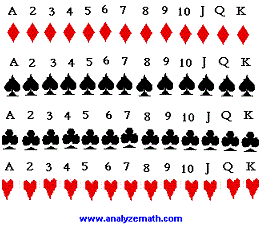how to find the probability
Tutorial on finding the probability of an event. In what follows, S is the sample space of the experiment in question and E is the event of interest. n(S) is the number of elements in the sample space S and n(E) is the number of elements in the event E.
Questions and their Solutions
Question 1
A die is rolled, find the probability that an even number is obtained.Solution
Let us first write the sample space S of the experiment.
S = {1,2,3,4,5,6}
Let E be the event "an even number is obtained" and write it down.
E = {2,4,6}
We now use the formula of the classical probability.
P(E) = n(E) / n(S) = 3 / 6 = 1 / 2
Question 2
Two coins are tossed, find the probability that two heads are obtained. Note: Each coin has two possible outcomes H (heads) and T (Tails).Solution
The sample space S is given by.
S = {(H,T),(H,H),(T,H),(T,T)}
Let E be the event "two heads are obtained".
E = {(H,H)}
We use the formula of the classical probability.
P(E) = n(E) / n(S) = 1 / 4
Question 3
Which of these numbers cannot be a probability?a) -0.00001
b) 0.5
c) 1.001
d) 0
e) 1
f) 20%
Solution
A probability is always greater than or equal to 0 and less than or equal to 1, hence only a) and c) above cannot represent probabilities: -0.00010 is less than 0 and 1.001 is greater than 1.
Question 4
Two dice are rolled, find the probability that the sum isa) equal to 1
b) equal to 4
c) less than 13
Solution
a) The sample space S of two dice is shown below.
S = { (1,1),(1,2),(1,3),(1,4),(1,5),(1,6)
(2,1),(2,2),(2,3),(2,4),(2,5),(2,6)
(3,1),(3,2),(3,3),(3,4),(3,5),(3,6)
(4,1),(4,2),(4,3),(4,4),(4,5),(4,6)
(5,1),(5,2),(5,3),(5,4),(5,5),(5,6)
(6,1),(6,2),(6,3),(6,4),(6,5),(6,6) }
Let E be the event "sum equal to 1". There are no outcomes which correspond to a sum equal to 1, hence
P(E) = n(E) / n(S) = 0 / 36 = 0
b) Three possible outcomes give a sum equal to 4: E = {(1,3),(2,2),(3,1)}, hence.
P(E) = n(E) / n(S) = 3 / 36 = 1 / 12
c) All possible outcomes, E = S, give a sum less than 13, hence.
P(E) = n(E) / n(S) = 36 / 36 = 1
Question 5
A die is rolled and a coin is tossed, find the probability that the die shows an odd number and the coin shows a head.Solution
Let H be the head and T be the tail of the coin. The sample space S of the experiment described in question 5 is as follows
S = { (1,H),(2,H),(3,H),(4,H),(5,H),(6,H)
(1,T),(2,T),(3,T),(4,T),(5,T),(6,T)}
Let E be the event "the die shows an odd number and the coin shows a head". Event E may be described as follows
E={(1,H),(3,H),(5,H)}
The probability P(E) is given by
P(E) = n(E) / n(S) = 3 / 12 = 1 / 4
Question 6
A card is drawn at random from a deck of cards. Find the probability of getting the 3 of diamond.Solution
The sample space S of the experiment in question 6 is shwon below

Let E be the event "getting the 3 of diamond". An examination of the sample space shows that there is one "3 of diamond" so that n(E) = 1 and n(S) = 52. Hence the probability of event E occurring is given by
P(E) = 1 / 52
Question 7
A card is drawn at random from a deck of cards. Find the probability of getting a queen.Solution
The sample space S of the experiment in question 7 is shwon above (see question 6)
Let E be the event "getting a Queen". An examination of the sample space shows that there are 4 "Queens" so that n(E) = 4 and n(S) = 52. Hence the probability of event E occurring is given by
P(E) = 4 / 52 = 1 / 13
Question 8
A jar contains 3 red marbles, 7 green marbles and 10 white marbles. If a marble is drawn from the jar at random, what is the probability that this marble is white?Solution
We first construct a table of frequencies that gives the marbles color distributions as follows
| color | frequency |
|---|---|
| red | 3 |
| green | 7 |
| white | 10 |
P(E) = Frequency for white color / Total frequencies in the above table
= 10 / 20 = 1 / 2
Question 9
The blood groups of 200 people is distributed as follows: 50 have type A blood, 65 have B blood type, 70 have O blood type and 15 have type AB blood. If a person from this group is selected at random, what is the probability that this person has O blood type?Solution
We construct a table of frequencies for the the blood groups as follows
| group | frequency |
|---|---|
| a | 50 |
| B | 65 |
| O | 70 |
| AB | 15 |
We use the empirical formula of the probability
P(E) = Frequency for O blood / Total frequencies
= 70 / 200 = 0.35
Exercises
a) A die is rolled, find the probability that the number obtained is greater than 4.b) Two coins are tossed, find the probability that one head only is obtained.
c) Two dice are rolled, find the probability that the sum is equal to 5.
d) A card is drawn at random from a deck of cards. Find the probability of getting the King of heart.
Answers to above exercises
a) 2 / 6 = 1 / 3
b) 2 / 4 = 1 / 2
c) 4 / 36 = 1 / 9
d) 1 / 52
More References and links
elementary statistics and probabilities.Home Page
how to find the probability
Source: https://www.analyzemath.com/statistics/probability_questions.html
Posted by: standleysamough.blogspot.com

0 Response to "how to find the probability"
Post a Comment